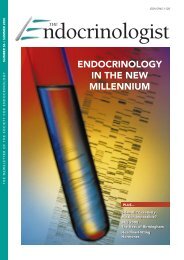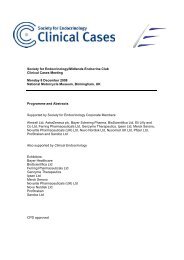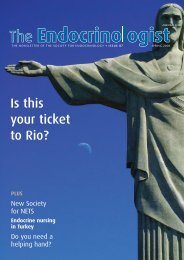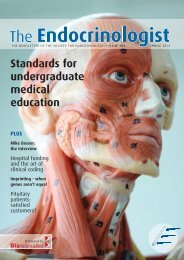Download issue 100 (pdf) - Society for Endocrinology
Download issue 100 (pdf) - Society for Endocrinology
Download issue 100 (pdf) - Society for Endocrinology
You also want an ePaper? Increase the reach of your titles
YUMPU automatically turns print PDFs into web optimized ePapers that Google loves.
Hot Topics<br />
Journal of <strong>Endocrinology</strong><br />
Exercise and insulin secretion<br />
The mechanism behind the enhanced insulin sensitivity<br />
developed during regular exercise is not well understood.<br />
Calegari and colleagues speculated that the decrease in<br />
glucose-induced insulin secretion could involve the AMPK<br />
pathway. Male Wistar rats underwent different periods of<br />
endurance training and assessment. They found that<br />
AMPK activation is enhanced by endurance exercise<br />
which leads to increased UCP2 protein content, resulting<br />
in decreased insulin secretion. This research has<br />
implications <strong>for</strong> treatment of type 2 diabetes.<br />
Read the full article in Journal of <strong>Endocrinology</strong> 208 257–264<br />
Glucocorticoids and IL-6 in pregnancy<br />
Glucocorticoids modulate the immune response during<br />
pregnancy. Cui and colleagues investigated the role of<br />
glucocorticoids in pregnancy in rats. Immune challenge in<br />
non-pregnant rats releases glucocorticoids and interleukin-<br />
6 (IL-6). This response is attenuated in late pregnancy.<br />
They also observed that during pregnancy, the<br />
lipopolysaccharide-induction of IL-6 is not corticosteronedependent.<br />
Thus, in late pregnancy, the glucocorticoid<br />
regulation of IL-6 is altered and could <strong>for</strong>m that basis of<br />
the specialized functions of IL-6 during pregnancy.<br />
Read the full article in Journal of <strong>Endocrinology</strong> 209 95–103<br />
Pancreatic islet neogenesis<br />
Transplantation of pancreatic islet-like cells and beta cells is<br />
a promising approach <strong>for</strong> treatment of type 1 diabetes<br />
mellitus. Milanesi and colleagues used a series of epigenetic<br />
manipulations to differentiate nestin-positive stem cells<br />
from rat bone marrow into pancreatic cell phenotypes in<br />
vitro. The cells expressed insulin and GLUT-2 and,<br />
importantly, secreted the hormone in a glucose-responsive<br />
manner. This is an exciting novel cellular system with<br />
potential therapeutic applications.<br />
Read the full article in Journal of <strong>Endocrinology</strong> 209 193–201<br />
Endocrine-Related Cancer<br />
Rac1 regulation of ER<br />
Rac1 stimulates migration and invasion in breast cancer<br />
cells. It is a downstream mediator of EGFR which activates<br />
ER; this lead Rosenblatt and colleagues to investigate Rac1<br />
and ER crosstalk. A novel mechanism was identified, with<br />
Vav3 as an upstream activator and Pak-1 as a downstream<br />
effector. They found ER activity in breast cancer cells<br />
could be inhibited using a Rac1 inhibitor, and that this<br />
inhibitor also decreased oestrogen-induced cell<br />
proliferation in tamoxifen-resistant breast cancer cells.<br />
Read the full article in Endocrine-Related Cancer 18 207–219<br />
ESR2 alleles and colorectal cancer<br />
Sex steroids may be involved in the higher incidence of<br />
colorectal cancer found in men. In this German casecontrol<br />
study, Sainz and colleagues studied 47 SNPs in sex<br />
steroid hormone signalling, transport or metabolism genes.<br />
The most significant CRC risk in women was associated<br />
with two variants of ESR2, suggesting that oestrogen<br />
influences normal colon function. Other genes with alleles<br />
which may be involved were HSD17B1, ABCB1 and SHBG.<br />
Read the full article in Endocrine-Related Cancer 18 265–276<br />
JOURNAL OF<br />
MOLECULAR ENDOCRINOLOGY<br />
MDM2 enhances oestrogen responsiveness<br />
Overexpression of murine double minute clone 2<br />
(MDM2) suppresses p53, and is there<strong>for</strong>e a potential<br />
prognostic indicator of cancer. Kim and colleagues used<br />
RNA interference to show that MDM2 enhances 17βestradiol-dependent<br />
growth and transactivation.<br />
Overexpression of MDM2 also coactivated ERα/SP1,<br />
enhancing ERα-mediated gene expression. MDM2 thus<br />
plays a critical role in the growth of ER-positive breast<br />
cancer cells, leading to the possibility that MDM2<br />
inhibitors would have therapeutic potential.<br />
Read the full article in Journal of Molecular <strong>Endocrinology</strong><br />
46 67–79<br />
Retinoic acid in endometrial cancer<br />
The molecular mechanisms behind the roles that retinoic<br />
acid plays in apoptosis and growth inhibition have<br />
remained unclear. Cheng and colleagues sought to<br />
identify specific retinoic acid receptor-α target genes in<br />
endometrial Ishikawa cells. Four highly regulated genes<br />
were subsequently validated as being regulated by the<br />
retinoic acid agonist AM580. Further, both retinoic acid<br />
and AM580 were shown, <strong>for</strong> the first time, to inhibit<br />
endometrial cancer cell proliferation. Retinoic acid thus<br />
has potential as a therapeutic agent.<br />
Read the full article in Journal of Molecular <strong>Endocrinology</strong><br />
46 139–153<br />
Clinical <strong>Endocrinology</strong><br />
PCOS investigation<br />
Polycystic ovary syndrome (PCOS) is the most common<br />
endocrine disorder in females and is often associated with<br />
diabetes and obesity. This thorough summary of research<br />
into PCOS by Pasquali and members of the PCOS Forum<br />
highlights a number of promising areas <strong>for</strong> future<br />
investigation and discussion of improved individualized<br />
therapeutic strategies <strong>for</strong> women with PCOS.<br />
Read the full article in Clinical <strong>Endocrinology</strong> 74 424–443<br />
Glucagonoma<br />
Glucagonoma is an exceedingly rare glucagon-secreting<br />
pancreatic neuroendocrine tumour (NET) arising from<br />
pancreatic islet alpha cells, and is often accompanied by a<br />
characteristic clinical syndrome. In this study, Eldor and<br />
colleagues present six patients diagnosed with the<br />
glucagonoma syndrome and their response to<br />
somatostatin analogue therapy. This study indicates that<br />
somatostatin analogues and an aggressive surgical<br />
approach offer symptom relief and tumour control.<br />
Read the full article in Clinical <strong>Endocrinology</strong> 74 593–598<br />
Central hypothyroidism treatment<br />
Central hypothyroidism is a rare cause of hypothyroidism,<br />
caused by the insufficient stimulation of an otherwise<br />
normal thyroid gland. While the mechanisms behind<br />
central hypothyroidism have been described, in this<br />
commentary Paolo Beck-Peccoz discusses the significant<br />
difficulties in diagnosis and treatment that remain,<br />
particularly the common pitfalls in diagnosis made on a<br />
biochemical basis and difficulties experienced with LT4<br />
therapy.<br />
Read the full article in Clinical <strong>Endocrinology</strong> June <strong>issue</strong><br />
T H E E N D O C R I N O L O G I S T • I S S U E 1 0 0 • S U M M E R 2 0 1 1<br />
19<br />
HOT TOPICS<br />
<strong>Society</strong> members<br />
get free access<br />
to Journal of<br />
<strong>Endocrinology</strong>,<br />
Journal of<br />
Molecular<br />
<strong>Endocrinology</strong><br />
and Endocrine-<br />
Related Cancer via<br />
www.bioscialliance.org


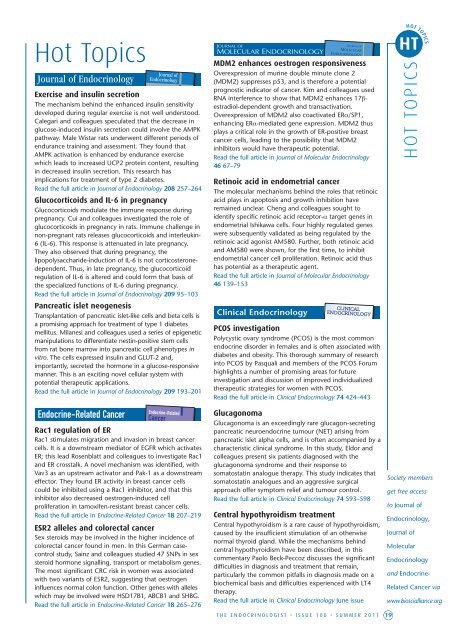
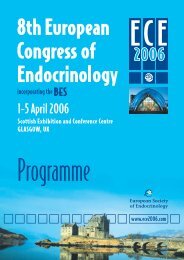
![The Endocrinologist | Issue 99 [PDF] - Society for Endocrinology](https://img.yumpu.com/48213777/1/184x260/the-endocrinologist-issue-99-pdf-society-for-endocrinology.jpg?quality=85)

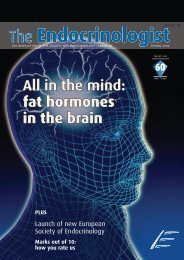
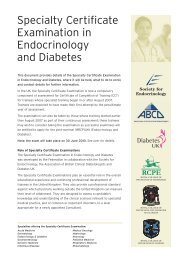
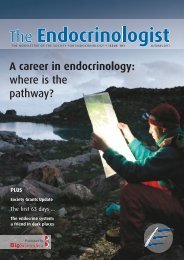
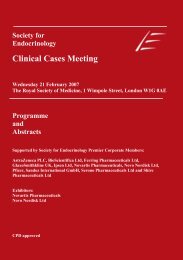

![The Endocrinologist | Issue 97 [PDF] - Society for Endocrinology](https://img.yumpu.com/40840065/1/184x260/the-endocrinologist-issue-97-pdf-society-for-endocrinology.jpg?quality=85)

